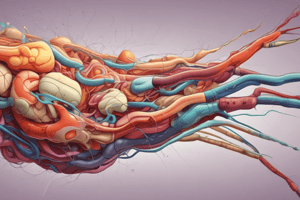Podcast
Questions and Answers
Which of these ways can pain be classified? (Select all that apply)
Which of these ways can pain be classified? (Select all that apply)
- Duration (correct)
- Color
- Pathophysiology (correct)
- Cause (correct)
What type of pain is most common?
What type of pain is most common?
Nociceptive pain
What type of pain originates from organs within the body?
What type of pain originates from organs within the body?
- Radiating Pain
- Visceral Pain (correct)
- Referred Pain
- Somatic Pain
What is neuropathic pain?
What is neuropathic pain?
Acute pain lasts less than ______ months.
Acute pain lasts less than ______ months.
What is the duration of chronic pain?
What is the duration of chronic pain?
Referred pain originates from internal organs but is felt in other locations.
Referred pain originates from internal organs but is felt in other locations.
What type of pain is characterized by sharp or burning sensations?
What type of pain is characterized by sharp or burning sensations?
What type of pain is perceived when there is no physical cause?
What type of pain is perceived when there is no physical cause?
Study Notes
Classifying Pain
- Pain can be classified by cause (e.g., cancer, cardiac), pathophysiology (e.g., nociceptive, neuropathic), or duration (acute vs chronic).
- Acute pain lasts less than six months; chronic pain persists beyond six months.
- Treatment varies by type and individual response to pain.
Nociceptive Pain
- Most common pain type, arising from stimulation of nociceptors due to trauma, inflammation, or tissue damage.
- Sensations can be sharp, burning, aching, cramping, or stabbing; can originate from visceral or somatic locations.
Types of Nociceptive Pain
- Visceral Pain: Originates from internal organs, typically dull and cramping, lasts longer (e.g., pancreatitis, cancer).
- Somatic Pain: Emanates from skin, muscles, or bones, sharp and localized, often short-lived (e.g., burns, fractures).
- Referred Pain: Felt in one location, though it originates from another (e.g., heart attack pain in the jaw).
- Radiating Pain: Extends from the source to adjacent areas (e.g., gastroesophageal reflux).
Other Pain Types
- Neuropathic Pain: Arises from nerve injury; persists post-stimuli; sensations include numbness and burning; associated with conditions like diabetes and cancer.
- Psychogenic Pain: Pain perceived without a physical cause, linked to emotional or behavioral factors (e.g., headaches, back pain).
- Acute Pain: Rapid onset, short duration; subsides with healing (e.g., injury, labor).
- Chronic Pain: Enduring pain lasting over six months; may be continuous or episodic; linked to conditions like fibromyalgia and arthritis.
Acute vs Chronic Pain
- Acute pain lasts less than six months and is self-limiting.
- Chronic pain exceeds six months and can be considered a disease condition, often resistant to treatment.
Nociceptive Pain Characteristics
- Nociceptive pain arises specifically from trauma, inflammation, or tissue damage.
- Distinction from referred, chronic, and phantom pain is essential for accurate diagnosis and treatment.
Studying That Suits You
Use AI to generate personalized quizzes and flashcards to suit your learning preferences.
Description
This quiz explores the classification of pain based on cause, pathophysiology, and duration. It delves into nociceptive pain and its various forms, including visceral, somatic, referred, and radiating pain. Test your knowledge on the characteristics and treatment of different pain types.




